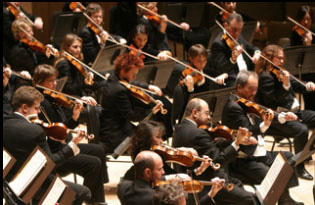
Bowed string instruments have formed the heart of the western orchestra since its beginnings in the early 17th century. When Claudio Monteverdi employed groups of families of instruments for one of the first staged operas in Europe, L’Orfeo, based on the Greek myth Orpheus and Eurydice, he set a trend for orchestral ensembles whose basic structural concept has been in use for five centuries. The orchestra of Monteverdi, as far as is known, employed the string section as the heart of the ensemble with two or more players on each string part. The terms “symphony orchestra” and “philharmonic” refer to a music ensemble in which string instruments will form the core of the ensemble and instruments from other families as are added as needed.
Unlike other instrument of the orchestra, the sound of bowed string instruments are for the most part uniform, the main differences in register than tone color. All bowed string instruments include four strings (sometimes five in the case of the double-bass), tuning pegs, a sound box, and a separate bow.
All string instruments create their sound by the musician running their bow along the strings which causes a sound vibration amplified by the sound box. Pitches are altered by lengthening or shortening the each string with the other hand on the strings at the neck. The use of bowed string instruments is limitless: solo sonatas, a solo or accompaniment in a song, string trio or quartet, and large orchestral music, to name but a few examples.
Special effects are created in more or less the same fashion on bowed string instruments, such as multiple-stops, i.e. playing multiple strings simultaneously, creating harmonics, and engaging in pizzicato (plucking the strings). It is important for the composer to understand each string instrument’s strengths, limitations, and weaknesses to create the desired musical experience. Enjoy exploring each of the main string instruments of the orchestra!
Select a string instrument (below) to explore the videos and explanations for that instrument.
